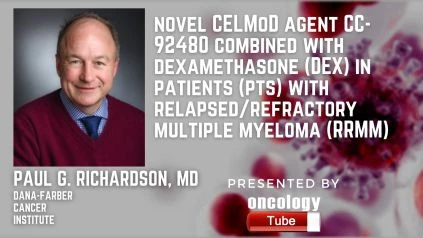Paul G. Richardson, MD of Dana-Farber Cancer Institute explains the abstract entitled First-in-human phase I study of the novel CELMoD agent CC-92480 combined with dexamethasone (DEX) in patients (pts) with relapsed/refractory multiple myeloma (RRMM).
Explanation:
The novel Cereblon E3 ligase modulator (CELMoD) agent CC-92480 is designed for the rapid, maximum degradation of Ikaros and Aiolos. In vitro, MM cell lines, including those resistant to lenalidomide (LEN) and pomalidomide (POM), have increased antiproliferative and tumoricidal activity, with high immune stimulatory activity.
Methodology:
Maximum tolerated dose (MTD), recommended phase 2 dose, protection, tolerability, and pharmacokinetics of CC-92480 + DEX in heavily pretreated RRMM pts were evaluated in a phase 1, multicenter, dose-escalation trial. On or within 60 days of their last MM treatment, qualifying pts had progression and were either resistant to or intolerant to, or not otherwise candidate for, currently available therapies. The escalating doses of CC-92480 + DEX (40 mg; 20 mg if ⇠75 yrs) were evaluated in several treatment schedules.
Outcomes:
As of Dec 24, 2019, CC-92480 + DEX had earned 66 pts. The median age was 67 years ( range 40-78), while the median number of previous regimens was 6 (range 2-13). Stem cell transplantation (67%), bortezomib (92%), LEN (89%), POM (83%), and anti-CD38 antibodies (78%) is used in prior therapies. 0.1–1.0 mg QD (10/14 days ⇠2), 0.8–1.0 mg QD (21/28 days), 0.2–0.8 mg BID (3/14 days ⇠2), and 1.6–2.0 mg QD (7/14 days ⇠2) were included in the CC-92480 doses studied. For both schedules of 10/14 x 2 and 21/28, MTD was 1.0 mg. In 58 (88 percent) pts, Grade 3–4 treatment-emergent adverse effects (TEAEs) were recorded. Neutropenia (53 percent), infections (30 percent), anemia (29 percent), and thrombocytopenia (17 percent), with 9 percent grade 3 fatigue, were the most common grade 3-4 TEAEs. 10 pts had dose-limiting toxicity (the majority linked to neutropenia) across various cohorts. The overall response rate (ORR) for the efficacy assessable population (n = 66) was 21 per cent (9 very strong partial responses [VGPRs]; 5 PRs). Efficacy was based on dose and schedule; 10 out of 21 (48 percent) pts responded (7 VGPR and 3 PR) through two 1.0 mg QD schedules (10/14 ⇠2 and 21/28), with response independent of refractory immunomodulatory drug (IMiD). Increases in plasma exposure and degradation of peripheral blood Ikaros and Aiolos is dose dependent. In bone marrow plasma cells, Ikaros and Aiolos decreased significantly in LEN- and POM-refractory pts.
Findings:
TEAEs of CC-92480 were predominantly associated with heavily pretreated myelosuppression, including triple-class-refractory, RRMM pts. Promising activity was observed at therapeutic doses of 48 percent ORR. In order to further refine the dosage and schedule, the research is continuing, with combination trials underway and cohorts for dosage expansion expected. Data on clinical trials: NCT03374085.

